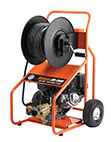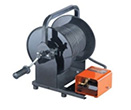Goodway's Ray Field and CDC's Nancy Messionner, MD on how your facility can best prevent Legionella outbreaks
16 JUN 2017
It’s likely that most facility managers in New York City have already heard the news this week about a police officer infected with Legionnaire Disease (LD). A poorly maintained water supply system at his police station was the likely source for a widespread disease that’s seen a quadrupling of reported cases in the last 15 years.
Legionnaires’ Disease Outbreaks Trending Up
As the summer heat begins to put a strain on facility cooling towers, more facility-triggered outbreaks are likely to follow. According to Ray Field, Director of Goodway Liquid Solutions, the upward trend in outbreaks will likely continue over the next few years as sub-standard maintenance practices, the wrong maintenance tools and shrinking maintenance budgets continue to hamper progress. In a related podcast entitled Legionella Outbreaks: Preventive Maintenance Practices and Chemical Solutions to Minimize Risk of Occurrence, Ray discusses the challenges facility managers face when battling the resilient bacteria.
"What it comes down to is good industrial hygienic practices,” Field says. "And if you look at cooling towers, in my estimation, they can be neglected in terms of care or maintenance up front when they’re started, in terms of washing them down, getting rid of scale accumulation in the tower fill that causes the air/water intimate contact that causes the cooling with the fan. Both chemical and mechanical solutions are really the best way to approach it, followed by a well-maintained water treatment program.” This is consistent with statements in the recent American National Standards Institute approved ASHRAE Standard 188 – 2015 entitled "Legionellosis: Risk Management for Building Water Systems.”
Just recently, the CDC arrived at a similar conclusion after analyzing 2,809 confirmed LD cases reported from 20 states and NYC. The report summarized that the number one way for facility managers to mitigate LD risk is to better manage and maintain the building’s water supply system. The study also revealed that roughly 80% of LD outbreaks in facilities were preventable and healthcare facilities in particular were more susceptible due, in part, to their more vulnerable populations and more complex water supply systems.
Here are three additional takeaways from the study:
• Legionella grows well in building water systems that are not adequately managed such as those in which disinfectant levels are low or water temperatures are warm.
• The size and complexity of the facility’s water system may increase the risk for Legionella growth.
• Effective water management and maintenance programs are highly recommended to prevent Legionella growth in buildings with large or complex water systems.
Facility Water System Components Susceptible to Legionella Growth
Legionella can grow in parts of building water systems that are continually wet, and certain devices can spread contaminated water droplets via aerosolization. Examples of these system equipment, components and devices include:
Cooling towers
Hot and cold water storage tanks
Water heaters
Water-hammer arrestors
Pipes, valves, and fittings
Expansion tanks
Water filters
Electronic and manual faucets
Aerators
Faucet flow restrictors
Shower heads and hoses
Centrally-installed misters, atomizers, air washers, and humidifiers
Non-steam aerosol-generating humidifiers
Eyewash stations
Ice machines
Hot tubs/saunas
Decorative fountains
How to Implement a Water Supply Management and Maintenance Program
To help facility managers and building owners prevent future outbreaks, the CDC also prepared a comprehensive thirty-six page water supply management guide to implementing industry standards. Facility managers who have previously implemented a risk management system will be familiar with its structure and the recommended stages:
Describe your building, its use and occupants, the plumbing and water handling equipment, with special attention to dead-legs or low flow areas, and outlets that form droplets
Analyze your water system to identify points where Legionella might grow due to suitable temperatures, or post-heating destruction of disinfectant, increased contaminants or other factors.
Working Smarter and OutSmarting Bacteria
Cooling tower and other equipment susceptible to bacteria growth (hot tubs, showers, fountains, air conditioning) may require a complete shut-down that takes time, inconveniences patrons and costs money. However, "clean-in-place” (CIP) maintenance solutions may drastically decrease the time, labor and burden of maintaining a water supply management program. For example, with the Goodway Cooling Tower Vacuum there’s no need to drain the tower – you can clean it while the tower is still online. Cooling demand is not interrupted, nor is the comfort of occupants. CIP solutions are typically more efficient and effective when compared to non-CIP solutions. For example, Goodway’s TFC-200 Cooling Tower Fill Cleaner used with a ScaleBreak Gel Descaler begins dissolving scale and grime from cooling tower fill on contact. This low viscosity acidic product is formulated specifically to adhere to and descale mineral deposits from cooling tower fill.
Final Thoughts: Clean Upfront
Whether a facility manager is in charge of an enormous water supply system or a modest system, cleaning up front takes priority over establishing a water supply program. In other words, basic preventive maintenance (PM) as equipment comes online for the first time or back online for the season must be your first step. That means using vacuums, pressure washers and the proper chemicals to safely and effectively remove scale.
Remember, your upfront PM should consider chemical and mechanical solutions that minimize labor costs and maximize effectiveness. Only then do you follow up with a well-maintained, measurable water management and treatment program.




